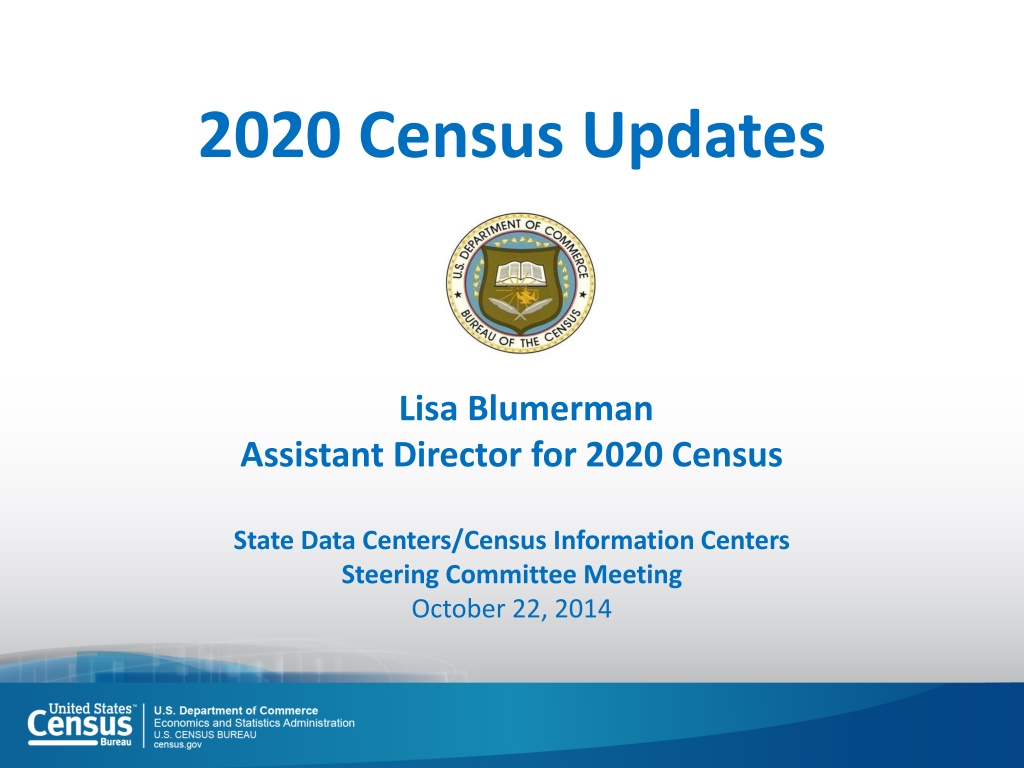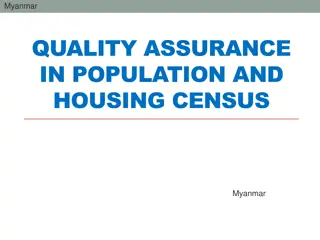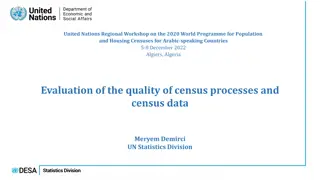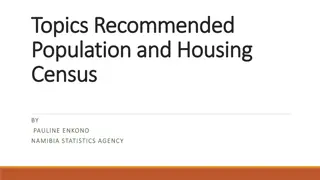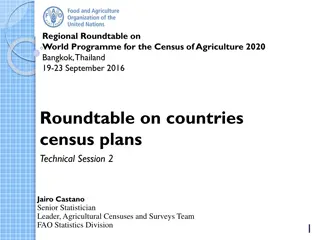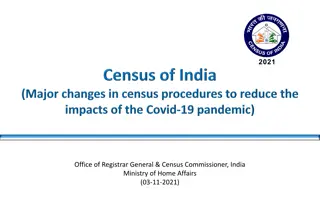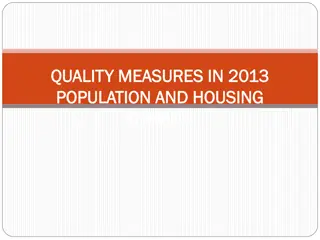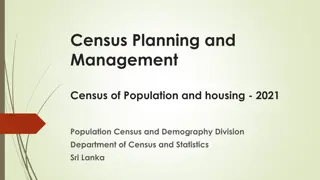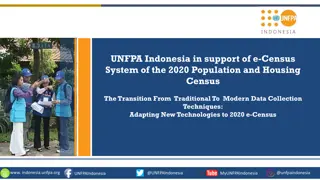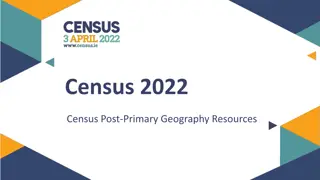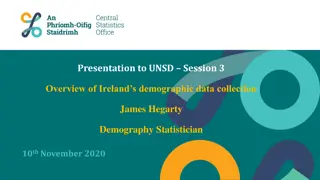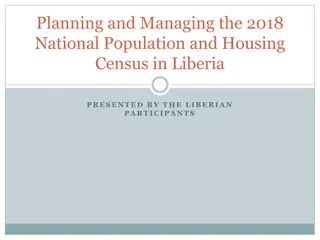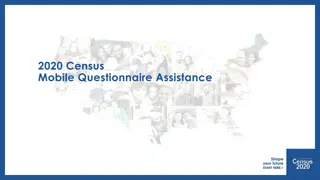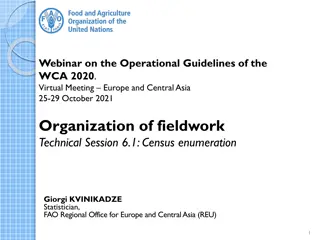Efforts to Optimize the 2020 Census Operations
The 2020 Census is focusing on operational research and development to enhance self-response rates, reengineer address canvassing, and utilize administrative records. By maximizing self-response through various channels such as internet options and social media advertising, the Census aims to reduce costly in-person data collection. Leveraging public-provided data and updated databases, the Census seeks to streamline operations and achieve significant cost savings. These strategic efforts reflect a commitment to efficiently reach a diverse and growing population in the upcoming census.
Download Presentation

Please find below an Image/Link to download the presentation.
The content on the website is provided AS IS for your information and personal use only. It may not be sold, licensed, or shared on other websites without obtaining consent from the author.If you encounter any issues during the download, it is possible that the publisher has removed the file from their server.
You are allowed to download the files provided on this website for personal or commercial use, subject to the condition that they are used lawfully. All files are the property of their respective owners.
The content on the website is provided AS IS for your information and personal use only. It may not be sold, licensed, or shared on other websites without obtaining consent from the author.
E N D
Presentation Transcript
2020 Census Updates Lisa Blumerman Assistant Director for 2020 Census State Data Centers/Census Information Centers Steering Committee Meeting October 22, 2014
2020 Census: Where Are We Today? In the next census, we will be trying to reach an increasingly diverse and growing population of around 330 million people in more than 140 million housing units. The Census Bureau is conducting research in order to inform key design decisions by the end of FY 2015. 2
2020Census Operational Research and Development Efforts Reengineering Address Canvassing Optimizing Self-Response Up to $5 Billion in Savings Through: Reengineering Field Operations Utilizing Administrative Records 3
2020Census Operational Research and Development Efforts Optimizing Self-Response Reengineering Address Canvassing Optimizing Self-Response Continually update address and map databases through various sources and methods to eliminate the need for nationwide in-field address canvassing in 2019 Utilizing Administrative Records Reengineering Field Operations 4
2020Census Operational Research and Development Efforts Optimizing Self-Response Reengineering Address Canvassing Maximize self-response (and thus Optimizing Self-Response minimize expensive in-person data collection) through the use of an Internet response option, social media advertising, and allowing respondents to respond without a unique identification code Utilizing Administrative Records Reengineering Field Operations 5
2020Census Operational Research and Development Efforts Reengineering Address Canvassing Utilizing Administrative Records Optimizing Self-Response Use data that the public has already provided to the government to reduce the nonresponse follow-up (expensive in-person data collection) workload Optimizing Self-Response Reengineering Field Operations 6
2020Census Operational Research and Development Efforts Reengineering Address Canvassing Reengineering Field Operations Optimizing Self-Response Reengineer field work through automation of case management and data collection, and using a new field structure with different field staff roles, work schedules, office configurations, and staffing ratios Optimizing Self-Response Utilizing Administrative Records 7
2014 Census Test Tested contact alternatives for self-response enumeration and nonresponse follow-up (NRFU) Compare response rates, cost, and data quality across strategies aimed at reducing costs by utilizing: Three contact strategies for optimizing self-response, including the use of pre- registration, e-mail, and mail Four panels for NRFU, varying the use of contact strategies and administrative records Self-response operations began in June 2014 NRFU operations completed in September 2014 Use the findings to inform later testing in FY 2015 8
2014 Census Test: Preliminary Self-Response Results Mail internet push invitation Letter 1stpostcard 2ndpostcard questionnaire High self-response rates (more than 55 percent of sample responded online) For future, test tweaks to this as a baseline strategy Response rates as of October 9, 2014 Internet TQA Mail Total 58.9% 5.3% 7.7% 71.9% Pre-registration (Notify Me) Low participation; need to test again in presence of promotion and advertising Additional burden may depress response System functionality worked well Non-ID Internet response Lower response than when an ID is provided Likely due to match/geocoding rates below 100% 9
2014 Census Test: Preliminary Self-Response Results (cont d) Email invitations and reminders Currently not an effective replacement for postal mail For future, consider supplementing (not replacing) paper reminders with e-mail reminders Automated voice invitations (AVI) No impact on response as prenotice or as a reminder 10
2014 Census Test: Preliminary Self-Response Findings Overall Success High self-response rate Letter 1stpostcard 2ndpostcard questionnaire contact strategy appears to be optimal thus far Non-ID interface has functioned well and no issues with workload Both email/text provider solutions were successfully deployed About 80% of the self-responders used the Internet Lessons Learned Email as an initial invitation and reminder contact strategy is not an effective replacement for mail pieces Short time frame between mailing limits our ability to exclude households who have already responded from subsequent reminders Volume of calls to the Telephone Questionnaire Assistance is much higher than projected 11
2014 Census Test: Nonresponse Follow-up Nonresponse Follow-up Status as of 9/22/2014 Cases in NRFU (as of 7/29) Cases % Cases Completed Cases % Cases Closed Panel Completed * Closed ** 13,253 12,553 8,101 12,340 46,247 10,199 8,921 6,900 10,446 36,466 77.0% 71.1% 85.2% 84.7% 78.9% 13,253 12,553 8,101 12,345 46,252 100.0% 100.0% 100.0% 100.0% 100.0% Control Reduced Contacts-no AR Reduced Contacts-AR Adaptive Design TOTAL Completed Cases includes (1) cases removed with AR before fieldwork and after 1 visit, (2) cases completed in CATI (complete interview with data), (3) cases completed in CAPI (complete interview with data), (4) cases completed in TQA, and (5) cases completed with self-response. Completed cases are tallied prior to unduplication efforts. Closed Cases includes (1) all completed cases as defined above plus (2) cases closed in CAPI with no data (noninterviews and other cases where field work has been discontinued). Late Self-Response as of 9/22/2014 Panel Cases in NRFU (as of 7/29) Cases in NRFU after initial AR removal (as of 7/29) Self-Response after NRFU Cut (7/29) % of Cases in NRFU Completed with Self- Response % of Cases in NRFU after initial AR removal Completed with Self-Response 13,253 12,553 8,101 12,340 46,247 13,253 12,553 3,056 11,833 40,695 3,781 3,371 543 3,000 10,695 28.5% 26.9% 6.7% 24.3% 23.1% 28.5% 26.9% 17.8% 25.4% 26.3% Control Reduced Contacts-no AR Reduced Contacts-AR Adaptive Design TOTAL Late Returns for cases that were removed using ARs are not included here. 12
2015 Testing Activities Address Validation Test 2015 Optimizing Self-Response Test 2015 Census Test 2015 National Content Test* * Results from this test not needed to make major design decisions at the end of FY 2015 13
2015 Testing Activities Address Validation Test Informing the performance of the methods and models that will help us develop the address list Testing the use of aerial imagery for change detection Assisting in the delineation of the Reengineered Address Canvassing workloads Full-Block Canvass: 10,100 blocks Partial-Block Canvass: 600-1000 blocks 14
2015 Testing Activities 2015 Optimizing Self-Response Test April 1, 2015 Census Day A site test conducted in the Savannah, Georgia area, including neighboring counties in South Carolina that constitute the media market for Savannah Continue testing pre-registration and Non-ID response to determine if we can optimize self and Internet response rates Pending the outcome of the 2014 Census Test, further refine the procedures for pre- registration in the Census Study the feasibility of implementing real-time processing for the Non-ID response option Research how advertising, outreach, and promotion can engage and motivate respondents for action 16
2015 Testing Activities 2015 Census Test April 1, 2015 Census Day Like the 2014 Census Test, this will be a site test and conducted in portions of Maricopa County, Arizona Reengineer the roles, responsibilities, and infrastructure for the field Evaluate the feasibility of fully utilizing the advantages of technology, automation, and real-time data to transform the efficiency and effectiveness of data collection operations Automate training for enumerators and managers Test and implement routing and/or navigation Reengineer the approach to case management Continue to research uses of administrative records to reduce and manage fieldwork 17
2015 Testing Activities 2015 National Content Test Will be a nationally representative sample, with oversampling of key sub- population groups Planned for a September 1 Census Day Full scope to be determined, but likely to continue testing of the following questions: Race and Hispanic origin Relationship Other possible topics such as within-household coverage questions 18
Whats Next? Besides the tests, and subject to funding, other work planned for FY 2015 and beyond includes improving methods for such things as: Field quality control Coverage measurement Enumerating hard to count populations We also need to provide ongoing support for Enterprise IT infrastructure and systems Support for the enterprise CEDCaP efforts Early developmental work on 2020 Census specific systems 19
Questions 20
